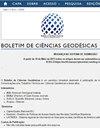基于大气模式时间分辨率的中性大气延迟预报的评估
IF 0.5
Q3 Earth and Planetary Sciences
引用次数: 1
摘要
在全球导航卫星系统(GNSS)中,电磁信号传播过程中中性大气的影响直接影响最终估计位置的质量,导致米制阶误差。使用大气模式是使这些误差最小化的一个好策略,因为考虑到数值模式处理的大气的特殊性,它有可能获得具有相同空间和时间分辨率的中性大气延迟。本文采用的是美国天气预报和气候研究中心(CPTEC)的区域模式,空间分辨率为15公里,时间分辨率为3小时。通常将3小时的延迟预测及时插值到GNSS应用中,这会影响每个插值历元获得的值的质量。较高的时间分辨率可以降低最终位置的误差。本文对分辨率分别为6小时和3小时的大气模式的延迟预报质量进行了评价。根据与大地测量数据相同位置的气象数据得出的估计延迟被认为是“真实的”。3小时的时间分辨率优于6小时的时间分辨率,特别是在初始预测阶段,流体静力分量的RMSE从1.25 cm降至0.2 cm。本文章由计算机程序翻译,如有差异,请以英文原文为准。
ASSESSMENT OF NEUTRAL ATMOSPHERIC DELAY PREDICTIONS BASED ON THE TEMPORAL RESOLUTION OF AN ATMOSPHERIC MODEL
In Global Navigation Satellite Systems (GNSS), the effects of neutral atmosphere in electromagnetic signal propagation impacts directly on the quality of the final estimated position, leading to errors in the metric order. Using an atmospheric model is a good strategy to minimize these errors, because it becomes possible to obtain a neutral atmospheric delay with the same spatial and temporal resolution, taking into consideration particularities of the atmosphere treated by a numerical model. The regional model of the Center for Weather Forecasting and Climate Studies (CPTEC) used in this paper has a spatial resolution of 15 km and a temporal resolution of 3 hours. Usually, the delay prediction of 3 hours is interpolated in time to GNSS applications and this can influence the quality of the values obtained in each interpolated epoch. Higher temporal resolutions can lead to lower errors in the final position. In this paper, the quality of delay predictions is evaluated for this atmospheric model with resolutions of 6 and 3 hours. The estimated delay, derived from meteorological data in the same location as the geodetic data, is considered as “truth”. The temporal resolution of 3 hours shows better results than using 6 hours, particularly for the hydrostatic component in the initial prediction period, RMSE of 1.25 cm was reduced to 0.2 cm in NEIA station.
求助全文
通过发布文献求助,成功后即可免费获取论文全文。
去求助
来源期刊

Boletim De Ciencias Geodesicas
Earth and Planetary Sciences-General Earth and Planetary Sciences
CiteScore
1.70
自引率
20.00%
发文量
10
审稿时长
3 months
期刊介绍:
The Boletim de Ciências Geodésicas publishes original papers in the area of Geodetic Sciences and correlated ones (Geodesy, Photogrammetry and Remote Sensing, Cartography and Geographic Information Systems).
Submitted articles must be unpublished, and should not be under consideration for publication in any other journal. Previous publication of the paper in conference proceedings would not violate the originality requirements. Articles must be written preferably in English language.
 求助内容:
求助内容: 应助结果提醒方式:
应助结果提醒方式:


